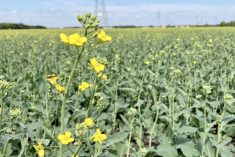MarketsFarm — After May and July canola contracts took hefty hits over the past the week, they skyrocketed to close out the calendar month following a pair of reports from the U.S. Department of Agriculture (USDA).
The department on Wednesday issued its first survey-based prospective planting report for 2021, which called for increased acres for soybeans and corn, but at numbers below market expectations. That sent prices on the Chicago Board of Trade (CBOT) — as well as the Intercontinental Exchange (ICE) — into a frenzy of daily limits.
Read Also

U.S. pulse group commits to doubling production in five years
The pulse industry in the United States has plans to double production and consumption of pulse crops by 2030, USA Pulses announced at their annual conference held in Spokane, Washington, July 7-10.
ICE canola’s four front months closed out trading with gains of $30 per tonne, up their daily limit. In turn, ICE raised the limit to $45/tonne effective Thursday.
Where prices go from here remains to be seen, but after a few weeks of needing fresh news, the commodities got much more than a good jolt to breathe new life into the markets.
With the average trade guess for planted U.S. soybean acres at about 90 million, the USDA report came in at 87.6 million acres.
That five per cent gain over plantings in 2020 is likely not enough to meet demand, according to Winnipeg-based independent trader Jerry Klassen.
“The way things are going with the export demand, it looks like we’re going to have another tight year on the beans. So that is supportive for canola,” Klassen said, noting markets will hold their value until the crops are more certain.
It was a similar story for U.S. corn, for which USDA forecast a tiny increase of 0.3 per cent in planted acres, at about 93 million. That also will mean pressure on corn, facing tight supplies. Thus, Klassen stressed that corn will likely be ruled out as a substitute for feed grains such as barley and wheat.
At this point in the marketing year, he said, attention will be turning away from the old-crop months to focus on the new-crop months.
Also, Klassen predicted a sharp increase in canola acres in Canada, perhaps to a record amount, in 2021. The most recent forecasts from Agriculture and Agri-Food Canada (AAFC) projected 20.1 million acres of canola to go into the ground this spring. Statistics Canada is scheduled to come out with its first survey-based set of projections at the end of this month.
With dryness across much of the Prairies, where the vast majority of canola is grown in Canada, there’s likely to be a premium — and that, he said, could see canola prices climb higher.
— Glen Hallick writes for MarketsFarm from Winnipeg.














